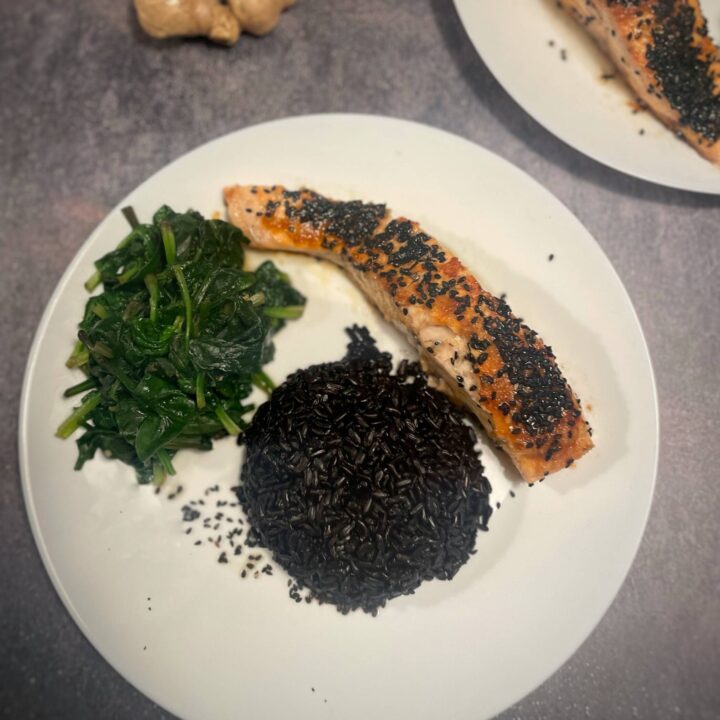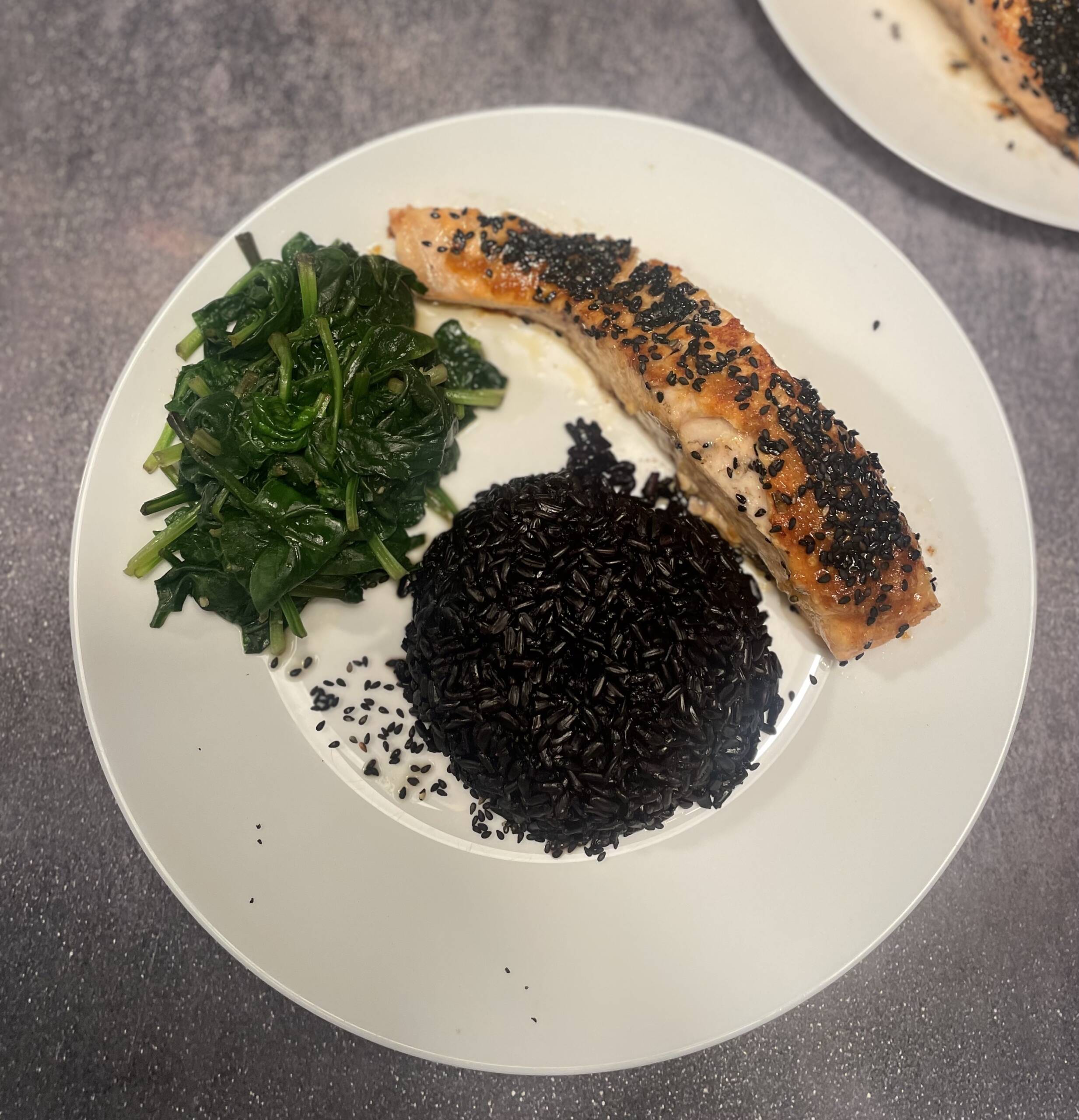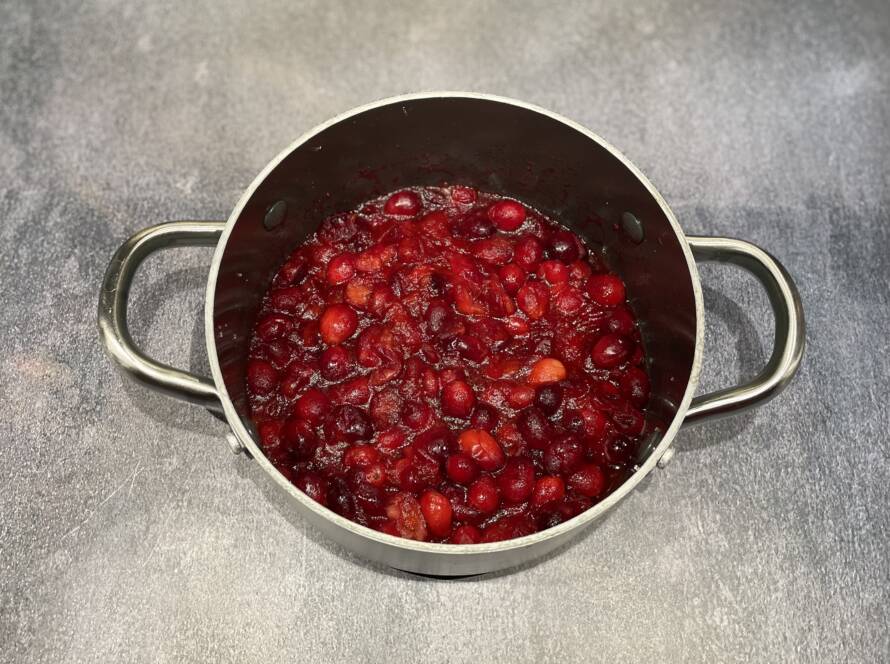
Teriyaki Salmon, Black Rice and Spinach
A quick, healthy, nutritious dish that is full of flavour and packed with protein, fibre and healthy omega 3 fatty acids.
Ingredients
- 300g (11oz) salmon (wild or organic)
- 350ml (11.8 fl oz or 1½ cups) filtered water
- 200g (7oz or 7-8 cups) baby spinach/bok-choi
- 100g (3.5oz or ½ cup) uncooked black rice
- 2 tbsp gluten-free soya sauce
- 30g (1oz) ginger
- 1 tbsp black sesame seeds
- 1 tbsp honey
- 1 tbsp rice wine vinegar
- 2 tsp coconut oil
- 1 tsp chilli powder
- 2 cloves of garlic
- 1 tbsp sesame oil
Instructions
- Cook rice as per packaging instructions
- Mince the garlic and set aside for 10 minutes
- Peel the ginger, then crush it in a pestle and mortar
- For the teriyaki sauce, add 10g (0.3oz) ginger, soya, honey, minced garlic, chilli powder & 100ml or ⅓ cup water to a small bowl and stir well.
- In a large pot, add 1 tsp of coconut oil, 20g ginger and spinach and stir-fry over medium heat for about 5-10 minutes. You can add a splash of boiled water to blanche if the dish seems a bit too dry. Once the spinach is cooked, turn off the heat, add the sesame oil and rice wine vinegar & stir well.
- Add a tsp of coconut oil to a pan, place the salmon upside down in the pan, add half of the teriyaki mixture and cook for 4 minutes on medium heat, then turn right-side up, add the rest of the teriyaki sauce and cook for another 4 minutes, then sprinkle the sesame seeds over the top, then serve with the black rice and spinach, and pour any of the left over teriyaki sauce from the pan over the dish.
Notes
Try to use wild-caught or organic salmon and organic vegetables. The black rice takes approximately 25 minutes to cook, so start with this step first. You can cook the spinach and salmon simultaneously. The dish has been prepared in a way as not to damage any of the healthy oils and fatty acids found in the sesame seeds and sesame oil. Coconut oil is a relatively stable oil that does not oxidise easily at higher temperatures, therefore it's been used in this dish to cook the vegetables and salmon.
Most soya sauces contain gluten, so try to find an organic, gluten free sauce to use. Only 2 tablespoons have been used in this dish to try and reduce the sodium content, as asian Cuisine is known to be very high in sodium, but you may want to replace the soy sauce with a low-sodium option if you are watching your salt intake. The teriyaki sauce may seem runny, however it will thicken and caramelise once added to the pan.
Black rice was known as the "forbidden rice" and was historically only made available to the noble families as a luxury grain. It is a nutrient-rich grain packed with antioxidants, particularly anthocyanins, which combat oxidative stress and reduce inflammation. Salmon is a healthy, protein which is high in omega 3 fatty acids, which support the nervous system and help reduce inflammation in the body. One serving supplies 47.7g protein, all the B vitamins and approximately 87% of the daily required vitamin D (depending on the quality of the fish).
Approximate micronutrient content per serving:
Vitamins
B1 (Thiamine) - 0.5mg (46%)
B2 (Riboflavin) - 0.9mg (86%)
B3 (Niacin) - 16.1mg (115%)
B5 (Pantothenic Acid) - 3mg (60%)
B6 (Pyridoxine) - 1.7mg (131%)
B12 (Cobalamin) - 4.6µg (191%)
Folate - 239.8µg (60%)
Vitamin A - 506.9µg (72%)
Vitamin C - 29.8mg (40%)
Vitamin D - 522IU (87%)
Vitamin E - 8.5mg (57%)
Vitamin K - 486.3µg (540%)
Minerals
Calcium - 182.9mg (18%)
Copper - 0.7mg (76%)
Iron - 6mg (33%)
Magnesium - 145mg (45%)
Manganese - 1mg (58%)
Phosphorus - 446.9mg (64%)
Potassium - 1738.1mg (67%)
Selenium - 72.1µg (131%)
Sodium - 859.1mg (57%)
Zinc - 1.9mg (24%)
% RDI based on an adult female
Nutrition Information:
Yield: 2 Serving Size: 400g (14oz)Amount Per Serving: Calories: 653kcalTotal Fat: 27.1gNet Carbohydrates: 50.2gFiber: 4.7gProtein: 47.7g



